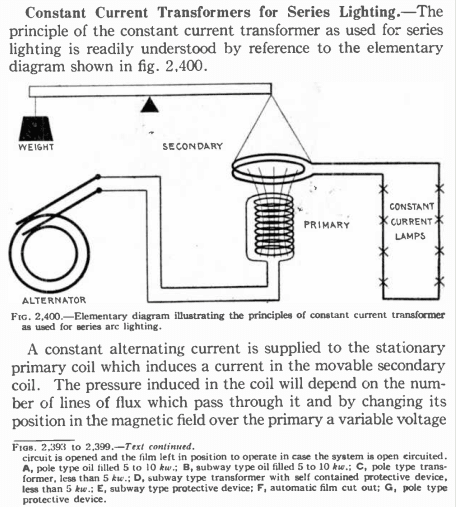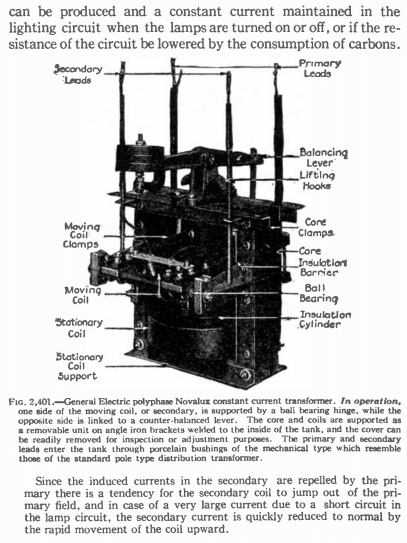Protection of series lighting circuits is interesting.
A short circuit is of no consequence on a series lighting circuit.
An open circuit is a fault condition. open circuit voltages may rise to several thousands of Volts.
Shorting buttons are used across lamps to complete the circuit in the event of filament failure.
Lamp protection buttons would fail shorted at around 100 Volts.
The original series circuits used incandescent lamps. In later years, series mercury vapour ballasts were developed and series circuits could be used with discharge lighting as well as with incandescent lighting.
Constant current transformer secondaries were protected by buttons that would fail shorted at several thousand Volts.
Currents could be 6.6 Amps, 7.5 Amps or 20 Amps. (I remember one other common voltage but not what it was. In the range of 6 Amps to 7.5 Amps.)
20 Amp circuits were used alongside rail trolley lines.
Consider: 400 Watts at 20 Amps = 20 Volts. The 20 Amp filaments could be seen to warm up and cool down similar to a toaster element but much faster. 20 Amp filaments were very robust and able to withstand the vibration caused by passing rail trolleys.
Series lamps used a special mogul socket.
The center contact was spring loaded to maintain good contact at the relatively high amperage.
The center contact also had a protruding tab. When the lamp was inserted, the tab was held down. As the lamp was screwed out, the tab was forced upwards until it contacted the bottom of the shell, to short out the lamp holder and keep the string in service.
Most of the circuits were ungrounded, but many developed grounds due to failure of the old insulation.
The guru of the series circuits had a little black book with information on every series circuit in the city.
Every year he would check each circuit for grounds.
If a ground was detected, he would go to work to locate the location.
He would start by breaking the circuit and checking until he located the run (between two lamp standards) with the ground.
Then he would bring out the Wheatstone Bridge and calculate the exact location of the fault. He would then record the information in the little book and leave without repairing it.
Eventually, it may be years later, a second ground would develop on the circuit. All of the lamps between the grounds would go out so the general location was easy to find.
The two grounds were often several city blocks apart.
John would check his book to see which ground he had located.
He would then proceed to the location of the latest ground and bring out the Wheatstone Bridge (Or the Electric Banjo as we called it).
John would carefully calculate the location of the new ground and record it in the book.
He would then instruct his helper to load everything into the truck.
When the truck was loaded, he would instruct his helper to drive, giving him block by block instructions.
When they reached the location of the first ground, John would get out of the truck and measure off so many feet from a lamp standard and tell his helper;
"Dig here."
Sure enough there would be a failed cable.
John had a drinking issue, but by keeping his information secret, he was able to drink his way to retirement without being fired for one of his escapades.
Like the day when an engineer (a small man) wanted to talk to John (a large man) out in the field.
The engineer saw john sitting in his truck and walked over and opened the door.
He didn't realize that John was passed out, drunk.
John fell out of the truck on top of the engineer and pinned him to the ground, still unconcious.
Incidents like this were covered up as management had no-one trained to replace John.
You can't make this stuff up.
I worked with John for one day. We set up the Electric Banjo and located a ground on a cable.
I watched over John's shoulder and got the reading.
As John was calculating, I was calculating.
"John, is it 15 feet to the ground?"
"NO! It's 110 feet."
"110 feet plus 15 feet on a 125 foot run? that works for me."
That was the last time that John let me near his truck.
--------------------
Ohm's law
Not just a good idea;
It's the LAW!


